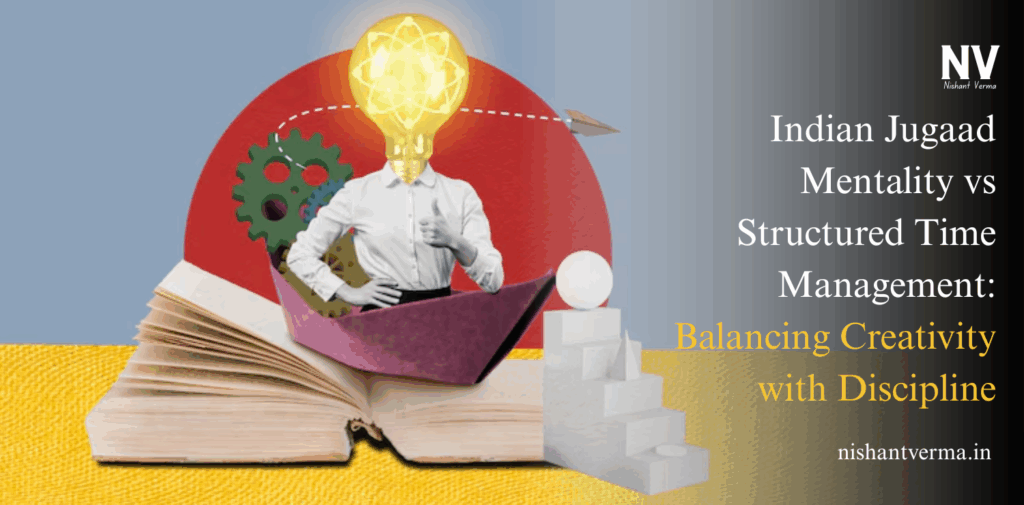India is a land of vibrant culture, diversity, and innovation. One of the most fascinating aspects of Indian problem-solving is the “Jugaad” mentality. It’s a word that doesn’t have a direct English translation, but in India, everyone knows what it means. Jugaad is all about finding smart, quick-fix solutions using limited resources. It’s a creative and flexible way to deal with everyday challenges.
On the other hand, structured time management is a more organized and planned approach. It is often associated with Western work cultures, where everything is scheduled, tracked, and optimized for productivity. In today’s fast-paced world, especially with globalization and competition, structured time management has become more important than ever.
So how do these two mindsets compare? Is one better than the other? Or can we find a balance between them? Let’s explore this in detail.
Understanding the Jugaad Mentality
Jugaad is not just a way to fix things – it’s a mindset. It’s about being resourceful, thinking on your feet, and making the most of what you have. From rural India to big cities, you’ll find examples of Jugaad everywhere. A cycle turned into a mobile charger, a broken fan fixed with a rubber band, or even a business idea started with almost no capital.
This mentality has helped Indians survive and thrive in challenging situations. It encourages out-of-the-box thinking and promotes resilience. It is especially useful in places where resources are scarce, systems are slow, or bureaucracy is heavy. For many people, Jugaad is a way of life.
However, there’s a downside. While Jugaad can solve immediate problems, it often ignores long-term planning. A temporary fix might work today but could lead to bigger issues tomorrow. Overdependence on Jugaad can lead to inefficiency, lack of consistency, and missed opportunities for improvement.

The Power of Structured Time Management
Structured time management is about using your time wisely and effectively. It includes planning your day, setting priorities, using calendars or planners, and breaking big tasks into smaller ones. This approach helps people meet deadlines, reduce stress, and increase productivity.
Successful companies around the world use structured time management to grow their business. It brings discipline to work and ensures that important tasks are not delayed or forgotten. Time management also allows individuals to balance their personal and professional lives better.
In India, more and more people, especially the younger generation, are adopting time management techniques. With digital tools like Google Calendar, Notion, Trello, and others, managing time has become easier than ever. Structured routines help students prepare for exams, professionals meet their targets, and entrepreneurs scale their businesses.
But structure alone can sometimes become rigid. It may limit spontaneous creativity or slow down decision-making when there’s too much planning involved. This is where Jugaad can still play a vital role.
Where Jugaad Wins and Where It Fails
Jugaad works brilliantly in situations where speed is more important than perfection. For example, during emergencies or when there’s no access to proper tools or support. It shines in startups, small businesses, or rural areas where innovation is born out of necessity.
However, Jugaad fails when systems need to be scalable, reliable, and consistent. Imagine a hospital running on Jugaad or a company trying to expand globally without proper processes in place. In such cases, lack of structure can be dangerous and unprofessional.
It’s also worth noting that Jugaad is usually a reaction to a problem, while structured management is a proactive approach. Jugaad often delays the root cause of a problem from being addressed, while structured planning helps prevent issues in the first place.

Bringing the Best of Both Worlds Together
Rather than choosing one over the other, a better idea is to combine both. This hybrid approach can be especially powerful in the Indian context. Here’s how:
- Use Jugaad when faced with unexpected problems, resource shortages, or situations that need creative solutions.
- Use structured time management for tasks that need discipline, planning, and long-term success.
- Encourage flexibility within a planned framework. This means allowing room for innovation but not at the cost of quality or deadlines.
- Train teams to think creatively but execute systematically. For example, brainstorming can be unstructured, but implementation should be organized.
This balanced mindset helps individuals and organizations stay competitive, adapt to changes quickly, and build sustainable growth.
Examples from Real Life
Take the example of a local vendor who used Jugaad to sell tea from a modified bicycle. His idea became so popular that it turned into a café chain. But to scale the business, he had to introduce structured processes like quality checks, employee training, and supply management.
Another example is from the world of Indian startups. Many founders start with Jugaad – creating MVPs (Minimum Viable Products) with limited resources. But once they receive funding or start growing, they shift to a more structured approach, hiring teams, setting deadlines, and focusing on KPIs.
Even in households, we often see a mix of both. A mother may use Jugaad to fix a leaking tap using tape, but she also manages her day in a structured way – planning meals, managing school timings, and handling budgets.

How You Can Start Using Both in Your Daily Life
If you want to make the most of your time and talents, here are some practical tips to blend Jugaad with structure:
- Start your day with a to-do list but leave some buffer time for unexpected things.
- Use digital tools to plan but be open to changing plans when needed.
- Practice creative thinking exercises to boost your Jugaad skills.
- Learn from mistakes – Jugaad may not always work, but every mistake is a lesson.
- Set long-term goals and track your progress regularly.
- Don’t shy away from structure – it’s not boring, it’s empowering.
Final Thoughts
India is a country full of bright minds and bold ideas. The Jugaad mentality is a reflection of our spirit – to never give up and to find a way, no matter what. But as we move forward in a world driven by technology, competition, and global standards, we also need structure.
By combining our natural talent for innovation with good time management habits, we can achieve more – not just faster, but also better. So instead of choosing between Jugaad and structure, let’s learn to master both.
Because in the end, true success lies not just in finding a solution – but in building a future that’s both smart and sustainable




